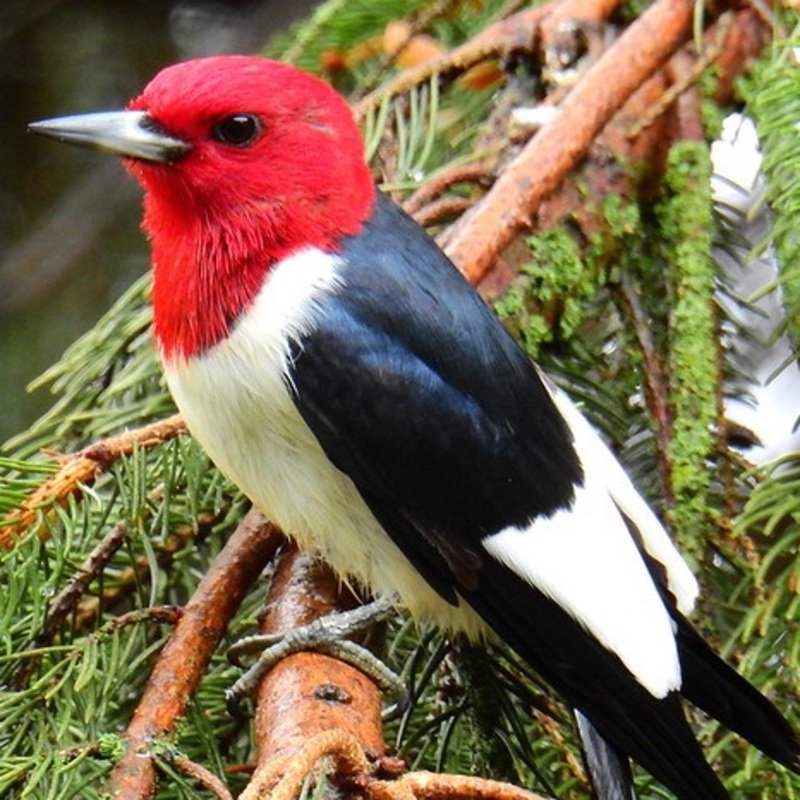The red-headed woodpecker or Melanerpes erythrocephalus in Latin is a medium-sized woodpecker that can be found in temperate North America’s northern forests. Throughout southern Canada and the eastern-central United States, the open country serves as their breeding habitat. They belong to the Picidae family. It has been downlisted from the near-threatened status on the Red List of Endangered Species maintained by the International Union for Conservation of Nature (IUCN) and is now considered to be of least concern.
Quick Overview: Melanerpes Erythrocephalus – Red-Headed Woodpecker
Body size: Around 8.5-9.25 in (22-23 cm) and a weight of 71 g (2.5 oz)
Main colors: Red, Black, White
Range: Eastern- Central United States
Migratory Bird: Yes
Best time of the year to see in the U.S.: All Year (January – December)
Conservation Status: Least Concern
Red-headed woodpecker Description
These woodpeckers are monomorphic. All of the above are bright red. Wings and tail are bluish-black, with large white squares on the rear of the wings and upper rump. The white on the wings makes them stand out when flying. Wings of immature birds have white patches. Immature red-headed woodpeckers have buffy-brown heads and necks that turn red after molting.

Size
These birds have a length of 8.5-9.25 in (22-23 cm) and a weight of 71 g (2.5 oz). Their wings could range from 16- 18 in (41-46 cm).
Feeding
Red-headed woodpeckers are omnivorous woodpeckers. Insects, spiders, earthworms, nuts, seeds, berries, wild and cultivated fruit, and occasionally small mammals make up their diet. These woodpeckers are known to feed on bluebirds, house sparrows, and chickadee eggs. They occasionally eat bark.
Habitat
Open woodlands, forest edges, and clearings are preferred. In deciduous forests, riverbanks, open woods, orchards, parks, and open country with scattered trees. They prefer areas with few large trees.
Behavior
Solitary red-headed woodpeckers defend breeding and feeding grounds in the spring and summer. Red-headed woodpeckers are primarily foragers. They are usually looking for food, whether it’s flying insects or ground food. In the autumn, these woodpeckers store food.
Melanerpes erythrocephalus Scientific Classification
- Kingdom: Animalia
- Phylum: Chordata
- Subphylum: Chelicerata
- Class: Aves
- Order: Piciformes
- Family: Picidae
- Genus: Melanerpes
- Species: Melanerpes erythrocephalus
Best time of the year to see
In the United States, the best time of year to see these birds is all year round, regardless of the season. This refers to any month of the year between January and December
Distribution of the Red-headed woodpecker in the USA
Red-headed woodpeckers are found across most of North America. From the Rocky Mountains to the Atlantic Ocean, and from southern Ontario to Texas, the Gulf of Mexico, and Florida. This once common bird is now scattered across its range.
The Red-headed woodpecker can be found in the following states in the United States – Alabama, Arkansas, Connecticut, Delaware, Georgia, Hawaii, Illinois, Indiana, Iowa, Kansas, Kentucky, Louisiana, Maine, Maryland, Massachusetts, Michigan, Minnesota, Mississippi, Missouri, Nebraska, New Hampshire, New Jersey, New York, North Carolina, North Dakota, Ohio, Oklahoma, Pennsylvania, Rhode Island, South Carolina, South Dakota, Tennessee, Vermont, Virginia, West Virginia, and Wisconsin.
